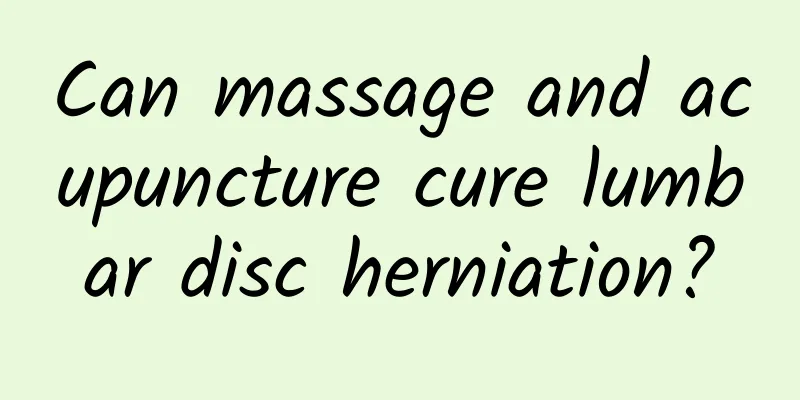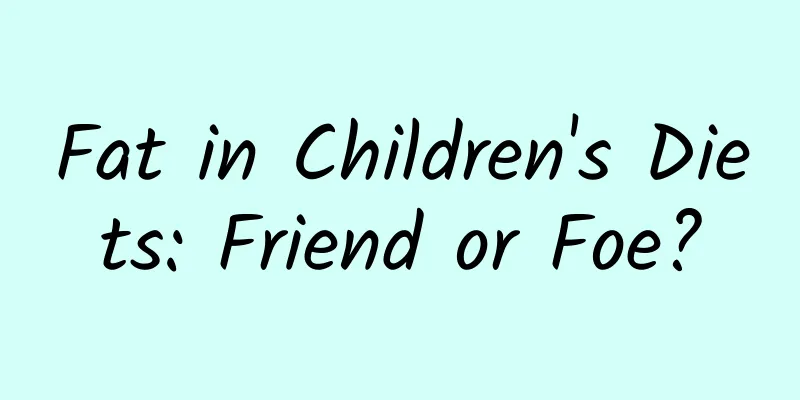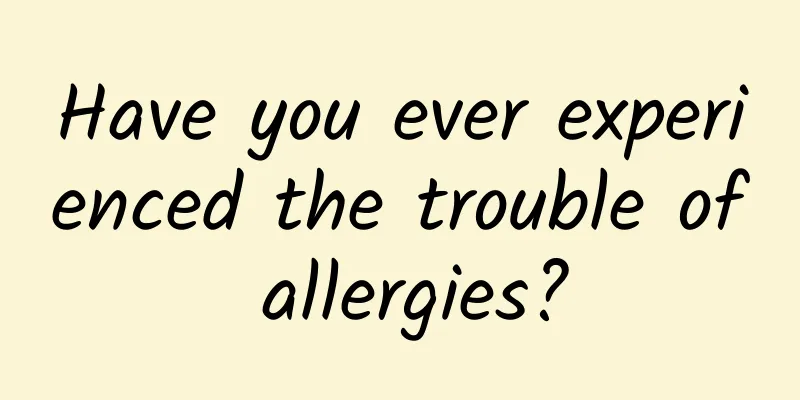Can massage and acupuncture cure lumbar disc herniation?

|
Lumbar disc herniation refers to a disease caused by the lumbar disc compressing or stimulating the intervertebral foramen and nerve roots posteriorly or laterally, resulting in compression or damage to the nerve roots. In recent years, lumbar disc herniation has become a problem for more and more people, and its incidence has gradually become younger. Most of them are caused by long-term unreasonable posture. The initial manifestation is just incorrect posture, hunchback, and local excessive force. Over time, it will cause chronic damage to soft tissues and form chronic low back pain such as lumbar muscle strain, so it is also called postural low back pain, and lumbar disc herniation is the result of further accumulation on this basis. Western medicine treatment of lumbar disc herniation is mainly based on drug treatment, which can improve symptoms such as pain and numbness. Now, more and more patients with lumbar disc herniation choose traditional Chinese medicine treatment. In addition to Chinese medicine conditioning, acupuncture and massage are also used to promote blood circulation in various systems of the body to achieve the effect of treatment. So, can Chinese medicine treatments such as massage and acupuncture cure lumbar disc herniation? Let's find out together. The picture comes from the Internet 1. What is lumbar disc herniation? The intervertebral disc refers to the tissue between the upper and lower vertebrae, which is composed of upper and lower cartilage plates, annular annulus fibrosus and the nucleus pulposus in the middle. Lumbar disc herniation is caused by degenerative changes in the intervertebral disc or external forces, which causes structural changes in various parts of the intervertebral disc, kyphosis or rupture of the annulus fibrosus, and prolapse of the nucleus pulposus from the ruptured annulus fibrosus. Because the spinal cord passes behind the intervertebral disc, the protruding tissue compresses the spinal nerves or cauda equina, causing symptoms such as low back pain, leg pain, and incontinence, which are called lumbar disc herniation. Lumbar disc herniation will initially affect the vertebral body at the site of the lesion, and then accumulate in different parts according to the innervation area of the involved nerves. The picture comes from the Internet 2. What are the common symptoms of lumbar disc herniation? 1. Pain in the waist and legs. Most patients with lumbar disc herniation have a history of low back pain symptoms for weeks or months, or a history of recurrent low back pain. The degree and severity of pain vary. Severe pain may affect turning over and sitting. Most patients' symptoms can be relieved after rest, but the pain may be aggravated by strenuous activities such as coughing, defecation or sneezing. The picture comes from the Internet 2. Numbness and radiating pain in the lower limbs. When a herniated disc stimulates and compresses the sensory fibers, it can cause numbness in the limbs. The numbness area can be distributed according to the affected nerves. About 95% of patients have low back pain and radiating pain in the lower limbs, mainly pain caused by sciatic nerve injury. The specific manifestation is that the pain spreads from the lower back, the back of the thigh, the outside of the calf to the foot, and the pain is more common on one side. The pain symptoms will be aggravated when the abdominal pressure increases due to coughing, sneezing, etc. [1] 3. Lower abdominal pain or pain in the front of the thigh. High lumbar disc herniation affects the 1st to 4th lumbar nerve roots, which will stimulate the communicating branches and sympathetic nerves between the nerve roots, and then cause pain in the lower abdomen and the front and inner thigh. 4. Cauda equina syndrome. In a small number of patients with intervertebral disc herniation, the intervertebral disc tissue will compress the cauda equina nerve, resulting in cauda equina syndrome. The main manifestations are urinary and bowel disorders, anal and perineal abnormalities. More serious patients may even experience symptoms such as incontinence and incomplete paralysis of the lower limbs. 5. Intermittent claudication. It is a manifestation of lumbar spinal stenosis. When walking, back pain, radiating pain in the lower limbs or numbness will increase with the increase of distance. The pain will be relieved when squatting or resting, but it will reappear after continuing to walk. 6. Muscle weakness: When the nerve root is severely compressed, it will lead to nerve paralysis and muscle paralysis, the most common of which is the inability to dorsiflex the big toe. In addition, some patients with severe illnesses may suffer from muscle paralysis and atrophy due to severe compression of nerve roots, and then develop into paralysis. 3. How do acupuncture and massage treat lumbar disc herniation? 1. Massage therapy The principle of massage therapy is to relax the muscles and activate the collaterals, regulate the muscles and restore them. The massage points are: Huantiao, Shenshu, Juliao, Chengfu, Juegu, Weizhong, Chengshan, Kunlun, Dachangshu, Yanglingquan, Yaoyangguan, Ashi points, waist and buttocks, and the back of the lower limbs. Operation method: The patient lies prone, and one-finger Zen push, press, and knead the two sides of the spine, buttocks, and the back of the lower limbs. Repeat 3 times. Press the acupoints with the thumb or elbow for five minutes. Rub the bladder meridian vertically and the lumbar sacral region horizontally until it is warm. The picture comes from the Internet Massage therapy can effectively reposition displaced lumbar intervertebral discs, dredge the meridians in the waist that are blocked due to compression, and has a significant effect in relieving symptoms such as pain and numbness. 2. Acupuncture treatment Acupuncture therapy is often used in traditional Chinese medicine treatment. It mainly uses stainless steel needles to stimulate the patient's acupuncture points and meridians, mobilize the body's inherent disease resistance, thereby preventing and curing diseases and alleviating related symptoms. The main acupoints for acupuncture treatment are Shenshu, Mingmen, Weizhong, Guanyuanshu, Qihaishu, Dachangshu, Yaoyangguan, and Jiaji. On this basis, acupoints are selected for treatment according to different syndrome types. For example, if the patient presents with waist pain, weak legs, a feeling of heat in the painful area, aggravated pain when heated, short and dark urine, yellow and greasy tongue coating, and a moist or stringy pulse, it is a case of damp-heat blocking the collaterals. In addition to the main acupoints, Yinlingquan, Sanyinjiao and other acupoints are added to promote dampness and dredge the collaterals.[2] Liver and kidney deficiency manifests as sore waist, dull pain, weakness in the legs and knees, and symptoms increase with fatigue and can be relieved by rest. Patients with predominantly yin deficiency manifest as restlessness, insomnia, fatigue, flushed face, red tongue with little coating, and stringy and thin pulse. In addition to the main acupoints, Zhaohai and Juegu can be added. Patients with predominantly yang deficiency manifest as cold hands and feet, pale face, cold waist and legs, deep and thin pulse, and pale tongue. Qihai, Guanyuan and other acupoints can be added. If the patient has stabbing pain in the waist, which is mild during the day and severe at night, and the patient cannot bend forward or backward easily in mild cases, and cannot turn sideways in severe cases, and the tongue is dark purple or has ecchymosis, and the pulse is sluggish, then it is the Qi stagnation and blood stasis type. Based on the main acupoints, the Xuehai, Geshu, Ciliao and other acupoints are combined [3]. Patients with the wind-cold and dampness type have symptoms of gradually worsening cold pain in the waist, difficulty turning sideways, persistent pain when lying still, fear of wind and cold, cold limbs, worsening on rainy days, pale tongue with white greasy coating, and deep and tight or soft pulse. Combined with Huantiao, Zhibian, Fengshi and other acupoints, the main purpose is to warm the meridians and dispel cold, and promote dampness and dredge the collaterals. The picture comes from the Internet Authoritative doctors said that acupuncture can indeed assist in the treatment of lumbar disc herniation. After a period of acupuncture treatment, combined with other treatment methods, it can effectively relieve symptoms such as low back pain, numbness, inflammation, edema, etc., which is conducive to physical recovery and improves the patient's quality of life. However, after acupuncture treatment, the following points need to be paid attention to in order to better obtain the treatment effect of lumbar disc herniation in patients. 4. What are the precautions for acupuncture treatment of lumbar disc herniation? First, it is not advisable to take a shower immediately after acupuncture. If patients with lumbar disc herniation take a shower immediately after acupuncture, it may aggravate the condition because the needle hole has not yet closed, which will affect the recovery of the condition. Generally, try not to take a shower on the day of acupuncture. Second, it is not advisable to be exposed to the wind after acupuncture. It takes some time for the wound to heal after acupuncture. If there is a breeze during acupuncture, it is easy to cause infection, leading to physical discomfort and even aggravating the condition. Therefore, acupuncture patients should keep warm when going out and avoid catching a cold or being exposed to the wind. Third, the number of acupuncture treatments needs to be controlled. The more times acupuncture is performed, the better it is. Long-term and multiple acupuncture treatments will not only fail to achieve more effective results, but may also cause endocrine disorders, severe diseases and other hazards. From the perspective of traditional Chinese medicine, lumbar disc herniation belongs to the category of "low back pain" and "arthritis". Acupuncture treatment can relieve pain, inhibit inflammatory mediators, relieve muscle spasms, stimulate nerves, improve local blood circulation, and then help restore nerve function and relieve nerve abnormalities caused by lumbar disc herniation compressing nerves. Massage treatment can relieve the compressed state of nerve roots, relax muscles and invigorate qi, remove blood stasis and relieve pain. Therefore, acupuncture and massage treatment of traditional Chinese medicine can have a good therapeutic effect on lumbar disc herniation, and can be treated by professional physicians. 5. How to perform waist function exercises? 1. Hip bridge training. Lie on your back with your knees bent, feet slightly wider than shoulder width apart, spread out to the sides, and arms spread out to the sides and placed on the ground. Push your hips upward, and push your hips up until your entire torso is basically in a straight line from shoulders to knees. Hold for 15 seconds, then slowly and controlledly lower your hips and rest for 5 seconds. The picture comes from the Internet 2. Plank. Place your hands in front of your body, with your forearms parallel to each other and your elbows perpendicular to the ground. Make fists with your hands, open your feet as wide as your hips, push the ground with your forefoot, tighten your core, lift your abdomen off the bed, and keep your body in a straight line. Hold for 30 seconds. The picture comes from the Internet 3. Cross-balance in the four-legged kneeling position. Kneel on the mat with the instep touching the ground, thighs and arms perpendicular to the mat, tighten the core muscles, keep the body still, and move the right leg backward and upward while the left hand forward and upward. Hold for five seconds and switch to the other side. The picture comes from the Internet 4. Flying Swallow. Lie face down on a flat bed or a cushioned floor without a pillow. Put your hands behind your waist; lift your head and chest up, leaving the bed; straighten your knees, and lift your legs (knees and below) up to leave the support surface. The picture comes from the Internet 5. Arch bridge pose: Lie on your back with your legs bent, and use your feet, elbows, and the back of your head as fulcrums (five-point support) to lift your hips up like an arch bridge. The picture comes from the Internet References: [1] Sun Xingliang. Observation on the therapeutic effect of massage combined with acupuncture in the treatment of lumbar disc herniation[J]. Journal of Traditional Chinese Medicine, 2011, 26(9):2. [2] Pan Mingzhu. Massage combined with acupuncture to treat 60 cases of lumbar disc herniation[J]. Chinese and Foreign Health Digest, 2011, 08(035):323-324. [3] Wei Xinhua, Zheng Ruoxian. Massage combined with acupuncture to treat 115 cases of lumbar disc herniation[J]. Massage and Rehabilitation Medicine, 2010, 1(6):2. |
Recommend
What are the benefits of eating sesame paste for pregnant women?
Sesame paste is something we often eat in our dai...
Female back pain
In life, many people have experienced back pain. ...
Female urine ketone weak positive
If a woman's menstruation is delayed for a lo...
Preventing infertility caused by artificial abortion
Artificial abortion is a remedy for contraceptive...
Do women need treatment for menopause?
Talking about menopause makes many women feel dee...
What are the differences between Chinese and Western table culture? How to hold a knife and fork in Western dining
As living standards improve, people's require...
Is painless abortion painful?
Many female friends will choose to have an aborti...
I am still bleeding after 20 days of confinement. Why?
Everyone knows that during pregnancy, the placent...
Is it good for women to soak their feet in white vinegar every day?
Is it good to soak your feet in vinegar every day...
I feel nauseous when brushing my teeth. Is this because I am pregnant?
Many people experience nausea when brushing their...
Do you know how many days it takes for fertilization to implant?
The formation of a child is a very long process. ...
Can’t wear makeup if you have acne?
Too absolute Acne is a common skin problem that p...
What is the treatment for dysmenorrhea?
Dysmenorrhea is a condition that occurs in many f...
How to sleep after sex to avoid pregnancy
If you don't want to get pregnant, you can ta...
Is it possible to lose weight successfully by hula hooping?
Summer is here again, and the annual weight loss ...









